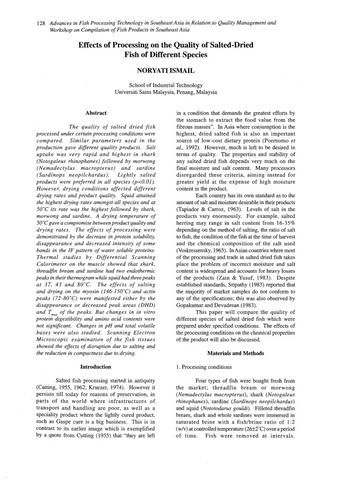| dc.contributor.author | Ismail, Noryati | |
| dc.contributor.editor | Hooi, Kok Kuang | |
| dc.contributor.editor | Low, Lai Kim | |
| dc.contributor.editor | Lim, Pang Yong | |
| dc.date.accessioned | 2019-05-27T09:11:36Z | |
| dc.date.available | 2019-05-27T09:11:36Z | |
| dc.date.issued | 1997 | |
| dc.identifier.citation | Ismail, N. (1997). Effects of processing on the quality of salted-dried fish of different species. In K. K. Hooi, L. K. Low, & P. Y. Lim (Eds.), Proceedings of the seminar on the advances in fish processing technology in Southeast Asia in relation to quality management, Singapore, 29 October - 1 November 1996 (pp. 128-152). Singapore: Marine Fisheries Research Department, Southeast Asian Fisheries Development Center. | en |
| dc.identifier.isbn | 9810088639 | |
| dc.identifier.uri | http://hdl.handle.net/20.500.12066/4839 | |
| dc.description.abstract | The quality of salted dried fish processed under certain processing conditions were compared. Similar parameters used in the production gave different quality products. Salt uptake was very rapid and highest in shark (Notogaleus rhinophanes) followed by morwong (Nemadectylus macropterus) and sardine (Sardinops neopilchardus). Lightly salted products were preferred in all species (p<0.01). However, drying conditions affected different drying rates and product quality. Squid attained the highest drying rates amongst all species and at 50°C its rate was the highest followed by shark, morwong and sardine. A drying temperature of 50° C gave a compromise between product quality and drying rates. The effects of processing were demonstrated by the decrease in protein solubility, disappearance and decreased intensity of some bands in the IF pattern of water soluble proteins. Thermal studies by Differential Scanning Calorimeter on the muscle showed that shark, threadfin bream and sardine had two endothermic peaks in their thermogram while squid had three peaks at 37, 43 and 80°C. The effects of salting and drying on the myosin (146-150°C) and actin peaks (72-80°C) were manifested either by the disappearance or decreased peak areas (DHD) and Tmax of the peaks. But changes in in vitro protein digestibility and amino acid contents were not significant. Changes in pH and total volatile bases were also studied. Scanning Electron Microscopic examination of the fish tissues showed the effects of disruption due to salting and the reduction in compactness due to drying. | en |
| dc.language.iso | en | en |
| dc.publisher | Marine Fisheries Research Department, Southeast Asian Fisheries Development Center | en |
| dc.title | Effects of processing on the quality of salted-dried fish of different species | en |
| dc.type | Conference paper | en |
| dc.citation.spage | 128 | |
| dc.citation.epage | 152 | |
| dc.citation.conferenceTitle | Proceedings of the Seminar on the Advances in Fish Processing Technology in Southeast Asia in Relation to Quality Management, Singapore, 29 October - 1 November 1996 | en |

